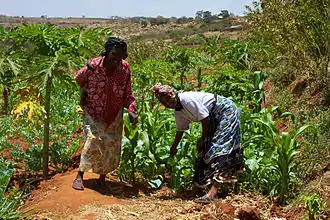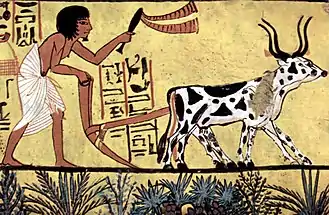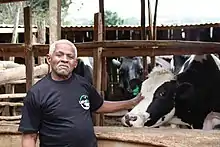Smallholding
A smallholding or smallholder is a small farm operating under a small-scale agriculture model.[1] Definitions vary widely for what constitutes a smallholder or small-scale farm, including factors such as size, food production technique or technology, involvement of family in labor and economic impact.[2] Smallholdings are usually farms supporting a single family with a mixture of cash crops and subsistence farming. As a country becomes more affluent, smallholdings may not be self-sufficient, but are valued primarily for the rural lifestyle that they provide for the owners, who often do not earn their livelihood from the farm. As the sustainable food and local food movements grow in affluent countries, some of these smallholdings are gaining increased economic viability. There are an estimated 500 million smallholder farms in the world, supporting almost two billion people.[3]

Small-scale agriculture is often in tension with industrial agriculture, which finds efficiencies by increasing outputs, monoculture, consolidating land under big agricultural operations, and economies of scale. Certain labor-intensive cash-crops, such as cocoa production in Ghana or Côte d'Ivoire, rely heavily on small holders; globally, as of 2008 90% of cocoa is grown by smallholders.[4] These farmers rely on cocoa for up to 60 to 90 per cent of their income. [5]Similar trends in supply chains exist in other crops like coffee, palm oil, and bananas.[6] In other markets, the importance of small scale agriculture in local economies has also increased food system investment in small holders. Today some companies try to include smallholdings into their value chain, providing seed, feed or fertilizer to improve production. Some say that this model shows benefits for both parties.[7] Especially for smallholders working in commodity crops, climate change introduces an increasing amount of variability to farmer economic viability; for example, Coffee production globally, is under increased threat, and smallholders in East Africa, such as in the Ugandan, Tanzanian or Kenyan industries, are rapidly losing both viable coffee land and productivity of plants.[8] Climate change impacts include shortening or disruption of growing seasons, reductions or increase in the area suitable for agriculture and declines in agricultural yields in many regions of the world.[9]
This is undermining global progress toward poverty alleviation, food security, and sustainable development as envisaged in goal 2 of sustainable development goals. [10]While the current focus has been increasing global food supply under climate change and the role played by smallholder communities, adaptation efforts are still hindered by lack of information on how smallholder farmers are experiencing and responding to climate change. There is lack of detailed, context-specific information on what climate change portends to smallholder farmers in different and widely varying agroecological environments and socio-economic realities, and what management strategies they are employing to deal with these impacts.[11][12]
Because smallholding farms frequently require less industrial inputs and can be an important way to improve food security in less-developed contexts, addressing the productivity and financial sustainability of small holders is an international development priority and measured by indicator 2.3 of Sustainable Development Goal 2.[13][2] Given the global COVID-19 pandemic, and the attendant disruptions of food systems, their role is becoming even more important. [14] As the world seeks to reduce the existing inequalities and poverty gaps, and the fact that over 3 billion people around the world cannot afford healthy diets, smallholder farms have a significant role to play in improving access to food. There are concerns that smallholders cannot play this role adequately if teething problems such as access to information, land, inputs, technology and markets are not properly addressed. Further, there is need to ensure that the need for food does not overshadow the importance to produce it within planetary boundaries that do not compromise the integrity of living systems (the biosphere) which we depend on.[15] For instance, in some geographies, pressure from land grabbing by industrial agriculture and soil degradation can lead small holders seeking economic viability to destroy local ecosystems and biodiversity.[16] Increasing productivity, especially amongst smallholder farms, is an important way to decrease the amount of land needed for farming and slow environmental degradation through processes like deforestation.[17] Since agriculture has such large impacts on climate change, Project Drawdown described "Sustainable Intensification for Smallholders" an important method for climate change mitigation.[17] Enhancing the habitat health, and improving connectivity between ecosystems while maintaining the high agricultural productivity of agricultural lands is desired at every level, and this should be guided by policy, especially on the technological front for smallholders.[18]
Productivity
| Agriculture |
|---|
 |
|
|
Small farms have many economic advantages. Local farmers generate a local economy in their rural communities. An American study showed that small farms with incomes of $100,000 or less spend almost 95 percent of their farm-related expenses within their local communities. The same study took in comparison the fact that farms with incomes greater than $900,000 spend less than 20 percent of their farm-related expenses in the local economy.[19] Thus, small-scale agriculture supports local economy.
Agricultural productivity is variously measured, and large-scale farming is often less efficient than small sustainable farms. Industrial single crop creates a high output per worker whilst, small-scale farmers produce more food per acre of land.[20] Smallholder farmers address inequities in land and water distribution by enforcing allocation proxies.[21]:124
Small-scale agriculture often sell products directly to the consumers. Disintermediation gives the farmer the profit that would otherwise go to the wholesaler, the distributor and the supermarket. About two thirds of the selling price would actually be lost for product marketing. Meanwhile, if farmers sell their products directly to consumers, they recover the totality of their product
Commonwealth countries
Smallholdings in Britain
In British English usage, a smallholding is a piece of land and its adjacent living quarters for the smallholder and stabling for farm animals. It is usually smaller than a farm but larger than an allotment, usually under 50 acres (20 ha). It is often established for breeding farm animals organically on free-range pastures. Alternatively, the smallholder may concentrate on growing vegetables by traditional methods or, in a more modern way, using plastic covers, polytunneling or cloches for quick growth.
Generally, a smallholding offers its owner a means of achieving self-sufficiency for its family's needs. They may be able to supplement their income by selling surplus produce at a farmers' market or at a permanent shop on the smallholding.
Hobby farms in Australia
In Western Australia, many small acre farms were established under the Agricultural Land Purchase Act to encourage settlement. The government purchased large land grants held by absentee owners and subdivided them according to the best use for the land: the development of orchids in Coondle, viticulture, horse breeding, sheep grazing, and high density crops like corn, and broad acre crops like wheat.
A hobby farm in Australia is a variety of smallholding that may be as small as 2 hectares up to a self-sustaining farm size, that allows the "city farmer" to have a house and a small number of animals or small crop fields or grape vines. In Western Australia, they are often termed Special Rural Properties for planning purposes.
Lifestyle blocks in New Zealand
In New Zealand, a lifestyle block is a smallholding valued primarily for the rural lifestyle it affords. Planning restrictions on subdividing farm land often lead to the creation of lifestyle blocks of minimum permissible size near urban areas.
Developing countries
In many developing countries, smallholding is a small plot of land with low rental value, used to grow crops.[22] By some estimates, there are 525 million smallholder farmers in the world.[23] These farms vary in land sizes, production and labor intensities.[24] The distribution of farm sizes depends on a number of agroecological and demographic conditions, as well as on economic and technological factors.[25] Smallholders are critical to local and regional food systems, as well as livelihoods, and especially so during periods of food supply chain disruptions.[26] Smallholders dominate production in certain key sectors such as coffee and cocoa. Various types of agribusinesses enterprises work with smallholding farmers in a range of roles including buying crops, providing seed, and acting as financial institutions.[27]
In low-income countries, women make up 43 percent of small holding agricultural labor, but produce 60–80 percent of food crops.[17]
Thailand
In 1975, there were 4.2 million smallholder farming households in Thailand. In 2013, Thailand had 5.9 million smallholder farming households. The average area of these smallholdings had shrunk from 3.7 hectares to 3.2 hectares over that period. Instead of farms getting larger and less numerous, as has been the case in the Global North, the reverse happened: they got smaller and more numerous.[28]
Kenya
Kenya's smallholder production accounts for 78 percent of total agricultural production and 70 percent of commercial production.[29] Majority of the smallholder population work in farm sizes averaging 0.47 hectares.[30] This represents the vast majority of Kenya's rural poor population who depend on agriculture for their livelihood.[31] Adverse risk events during the period 1980–2012

led to production losses in smallholder farms resulting in a drop in agricultural gross domestic product (GDP) of 2 percent or more.[31] Increasing the productivity of smallholder farmers is encouraged due to its potential of improving food availability, increasing rural incomes, lowering poverty rates, and growing the economy.[31] Diversification of crops in smallholder farms is one of the potential strategies in sustaining agricultural productivity, and copping with marketing risks.[32] It is also a transitional step from subsistence to commercial agriculture. Age, education of household head, type of crops, cropping system, amount of credit, and irrigation facilities are some of the factors influencing diversification in smallholder farms.[33]
International policy
Because smallholding farms frequently require less industrial inputs and can be an important way to improve food security in less-developed contexts, addressing the productivity and financial sustainability of small holders is an international development priority and measured by indicator 2.3 of Sustainable Development Goal 2.[13][2] The International Fund for Agricultural Development has an ongoing program for Adaptation for Smallholder Agriculture.[34]
See also
References
- "Small-Scale Agriculture - an overview | ScienceDirect Topics". www.sciencedirect.com. Retrieved 2020-10-17.
- Khalil, Clara Aida; Conforti, Piero; Ergin, Ipek; Gennari, Pietro (June 2017). DEFINING SMALL-SCALE FOOD PRODUCERS TO MONITOR TARGET 2.3. OF THE 2030 AGENDA FOR SUSTAINABLE DEVELOPMENT (PDF) (Report). FAO STATISTICAL DIVISION.
- "Operating model – ifad.org". www.ifad.org. Archived from the original on 2013-05-05. Retrieved 2018-01-02.
- "How many smallholders are there worldwide producing cocoa? What proportion of cocoa worldwide is produced by smallholders?". www.icco.org. Retrieved 2020-10-17.
- "Why Sustainable Cocoa Farming Matters for Rural Development". www.csis.org. Retrieved 2020-11-30.
- Schneider, Kate; Gugerty, Mary Kay (August 17, 2010). Impact of Export-Driven Cash Crops on Smallholder Households (Report). Evans School Policy Analysis and Research.
- Christina Gradl; et al. (March 2013). "Promising agribusiness". dandc.eu.
- Welle (www.dw.com), Deutsche. "How climate change threatens African coffee farmers | DW | 18.11.2020". DW.COM. Retrieved 2020-11-19.
- "World Agriculture: Towards 2015/2030 - An FAO perspective". www.fao.org. Retrieved 2020-12-01.
- Martin. "Goal 2: Zero Hunger". United Nations Sustainable Development. Retrieved 2020-11-30.
- Harvey, Celia A.; Saborio-Rodríguez, Milagro; Martinez-Rodríguez, M. Ruth; Viguera, Barbara; Chain-Guadarrama, Adina; Vignola, Raffaele; Alpizar, Francisco (2018-08-14). "Climate change impacts and adaptation among smallholder farmers in Central America". Agriculture & Food Security. 7 (1): 57. doi:10.1186/s40066-018-0209-x. ISSN 2048-7010. S2CID 52048360.
- Kristjanson, Patti; Neufeldt, Henry; Gassner, Anja; Mango, Joash; Kyazze, Florence B.; Desta, Solomon; Sayula, George; Thiede, Brian; Förch, Wiebke; Thornton, Philip K.; Coe, Richard (2012-09-01). "Are food insecure smallholder households making changes in their farming practices? Evidence from East Africa". Food Security. 4 (3): 381–397. doi:10.1007/s12571-012-0194-z. ISSN 1876-4525. S2CID 16140399.
- "2.3.1 Productivity of small-scale food producers | Sustainable Development Goals | Food and Agriculture Organization of the United Nations". www.fao.org. Retrieved 2020-10-17.
- "Building the Resilience of Smallholder Farmers | Land & Water | Food and Agriculture Organization of the United Nations | Land & Water | Food and Agriculture Organization of the United Nations". www.fao.org. Retrieved 2020-12-01.
- "The nine planetary boundaries". www.stockholmresilience.org. 2009-09-17. Retrieved 2020-12-01.
- "Future Smallholder Deforestation: Possible Palm Oil Risk". Chain Reaction Research. 2019-10-29. Retrieved 2020-10-17.
- "Sustainable Intensification for Smallholders". Project Drawdown. 2020-02-06. Retrieved 2020-10-16.
- "The nine planetary boundaries". www.stockholmresilience.org. 2009-09-17. Retrieved 2020-12-01.
- Chism, J.W.; Levins, R.A. (1994). "Farm". Minnesota Agricultural Economist. Spring 1994 (676).
- Gorelick, Steven; Norberg-Hodge, Helen (2002). Bringing the Food Economy Home: Local Alternatives to Global Agribusiness. Kumarian Press (US). Retrieved 5 November 2014.
- Condon, Madison; Komakech, Hans; Zaag, Pieter van der (2012-01-01). "The Role of Statutory and Local Rules in Allocating Water between Large- and Small-Scale Irrigators in an African River Catchment". Water SA. 38 (1): 115.
- Bunnett, R.B. (2002). Interactive Geography 4, pp. 125, 315. SNP Pan Pacific Publishing. ISBN 981-208-657-9.
- Nagayets,Oksana (2005). The Future of Small Farms. International Food Policy Research Institute and Overseas Development Institute Vision 2020 Initiative, p. 356.
- UNCTAD (2015). Commodities and Development Report 2015-Smallholder Farmers and Sustainable Commodity Development. UN. pp. 2–21.
- FAO (2015). The economic lives of smallholder farmers-An analysis based on household data from nine countries. FAO.
- Savary, Serge; Akter, Sonia; Almekinders, Conny; Harris, Jody; Korsten, Lise; Rötter, Reimund; Waddington, Stephen; Watson, Derrill (2020-08-01). "Mapping disruption and resilience mechanisms in food systems". Food Security. 12 (4): 695–717. doi:10.1007/s12571-020-01093-0. ISSN 1876-4525. PMC 7399354. PMID 32837660.
- International Finance Corporation (2013). Working with Smallholders: A Handbook for Firms Building Sustainable Supply Chains, p. 12. http://www.farms2firms.org
- Rigg, Jonathan. "Modern country, persistent smallholder: Explaining the puzzle of Thailand's truncated agrarian transition". The Asia Dialogue. University of Nottingham, Asia Research Institute. Retrieved 23 April 2020.
- Bank, World; Agriculture, International Center for Tropical (2016-01-15). "Climate-Smart Agriculture in Kenya". Cite journal requires
|journal=(help) - FAO (2015). The economic lives of smallholder farmers-An analysis based on household data from nine countries. FAO.
- D’Alessandro, Stephen P.; Caballero, Jorge; Lichte, John; Simpkin, Simon (November 2015). "Kenya". hdl:10986/23350. Cite journal requires
|journal=(help) - Kemboi, Evans; Muendo, Kavoi; Kiprotich, Collins (2020-01-01). Yildiz, Fatih (ed.). "Crop diversification analysis amongst smallholder farmers in Kenya(empirical evidence from Kamariny ward, Elgeyo Marakwet County)". Cogent Food & Agriculture. 6 (1): 1834669. doi:10.1080/23311932.2020.1834669. ISSN 2331-1932.
- Kemboi, Evans; Muendo, Kavoi; Kiprotich, Collins (2020-01-01). "Crop diversification analysis amongst smallholder farmers in Kenya(empirical evidence from Kamariny ward, Elgeyo Marakwet County)". Cogent Food & Agriculture. 6 (1). doi:10.1080/23311932.2020.1834669. ISSN 2331-1932.
- "Adaptation for Smallholder Agriculture Programme". IFAD. Retrieved 2020-11-07.
Further reading
- Graham, Peter Anderson (1911). . In Chisholm, Hugh (ed.). Encyclopædia Britannica. 1 (11th ed.). Cambridge University Press. pp. 699–704. This provides an extensive historical and global view as of the early 20th century.
External links
| Look up smallholding in Wiktionary, the free dictionary. |